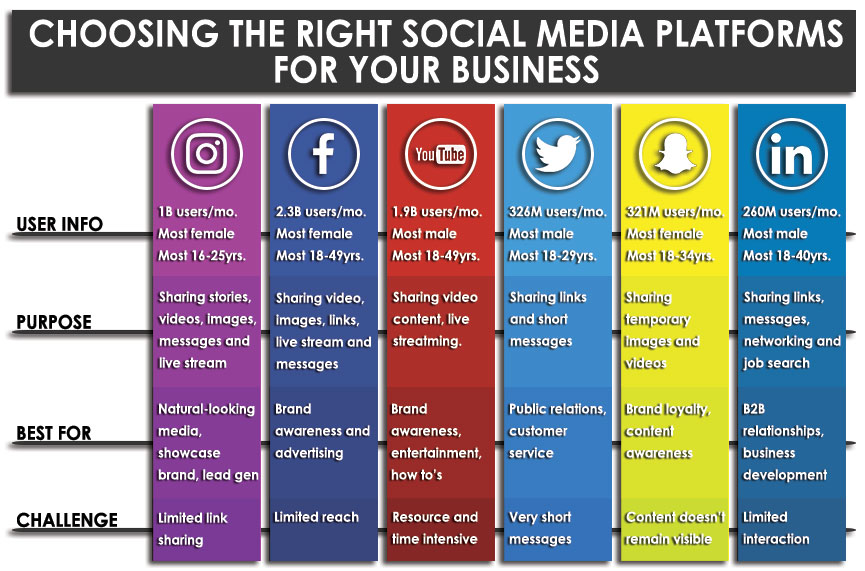Marketing your business can seem like a daunting task if you’ve not yet mastered it, yet, it is crucial to the success of your business regardless of how long you’ve been in business. It’s important to keep in mind that effective marketing evolves and that it can change relatively quickly. However, some of the fundamental concepts remain the same. Two things that remain constant are the importance of good products/services and excellent customer service. Having these two as top priorities will make your marketing efforts much more effective. Read through these tips on marketing a small to mid-size business.
What Is Marketing?
Let’s go back to basics. A simple definition search on Google will get right to the point: Marketing is the action or business of promoting and selling products or services.
Of course, it can involve various forms of advertising and can also involve market research, testing, analytics, software, third party agents, and much more.
How to Choose the Right Marketing Strategy
First of all, there is not a one-size-fits-all answer to this question. However, here are some suggestions to get you started or improve your current efforts:
Understand Your Business
You may think, “Of course, I understand my business. It’s my business.” However, it is important to take the working knowledge you have about your business and add the thoughts and feelings of your customers to your perspective. If you deal with customers face to face, you may get some valuable queues from those interactions. You may also have an idea of customer sentiment from customer service records. In addition, you may wish to share short surveys or questionnaires with your customers and politely ask that they participate. Having a well-rounded perspective of your business will help your overall marketing strategy.
Have a CRM System
A viable customer relationship management (CRM) system can come as software that you incorporate into your business administration, such as the inexpensive (even free) HubSpot. It can also simply be a “system” you have worked out to keep track of your customers and your interactions with them. The most important thing is to have some type of customer and transactional information that you can leverage to market to customers and prospects.
Choose the Right Channel for Marketing
There are various ways to reach potential customers. It is important to know that although traditional forms of marketing are still around (TV, radio, print, mail, etc.) marketing in the digital space (web via mobile and computers) is becoming more and more dominant. This isn’t to say that you shouldn’t try a variation that includes traditional forms of marketing. Learn as much as you can about the various outlets for advertising. Incorporate that knowledge with what you know about your business and your customers and test a few methods out. Yes, test. By experimenting, you’ll find which form(s) are most effective for your business. More on that later.
Here are some marketing channels to consider:
Websites— It is a good idea for most businesses to have a website. Getting a website up and running doesn’t necessarily require a special developer and a large budget as it once did. In fact, some fairly affordable options are available through user-friendly platforms such as Wix and Squarespace. Such website builders pride themselves in their drag-and-drop functionality and relatively low setup time. Of course, if you require a more robust website you’ll probably want to explore the higher tiers of functionality. Regardless of what you use to build your site, remember that you want your message to be clear, to speak to the need of the customer, and be up to date. A website should have the following basics:
- Information about your company and the services it offers
- Contact information that includes an online method to be reached
- Business credentials you wish to display
- Information that educates visitors on your services and sets proper expectations for those considering doing business with you
- (Optional) Sections for FAQs, testimonials, images, and more
E-mail Marketing— This is a powerful tool that goes hand-in-hand with your customer relationship management (CRM). E-mails can be as intricate or as simple as you wish. Many times, simpler is better. E-mail marketing can be divided into two categories: customer e-mails and prospect e-mails. For customers, you’ll want to nurture them through occasional communication that provides relative information or offers that they may be interested in. For prospects, you could send occasional reminders about your products or services as well as provide a call to action so that you can assist them.
You can be on your way to set up an e-mail marketing strategy through affordable platforms like MailChimp (which has a free option) and Constant Contact. The advantage of using one of these methods versus say, your Gmail, is that you have the capability of customizing professional looking e-mails based on simple-to-use templates. You can even access some basic metrics to see how your well your e-mails are performing. Keep the following in mind when working on your e-mail marketing strategy:
- Keep the subject line short and straightforward (don’t try to trick people into opening your email).
- Always provide an option to unsubscribe from your messages.
- Be clear about the purpose of the e-mail and what you’re asking them to do (purchase, read more, visit, etc.)
- Follow federal CAN-SPAM regulations (no one likes junk mail).
Social Media— What was once considered a way for crazy kids to waste time posting pictures and gossiping is now a powerful method of communication for all, including businesses. However, before you jump into every social media account you can think of, consider the use of the platform and your ability to maintain a constant presence on it. No one likes visiting an abandoned account that last posted something in 2014. Worse yet, an account that shares something that isn’t relevant to the viewers, the business, or the nature of the platform. Here’s a breakdown of popular social media platforms and their use:
 Â Instagram: Best for sharing photos and videos that feel real and not staged. Great way to reach millennials.
 Instagram: Best for sharing photos and videos that feel real and not staged. Great way to reach millennials.
 Â Facebook: The biggest social platform but with limited reach. Great for images, videos, links, brand loyalty.
 Facebook: The biggest social platform but with limited reach. Great for images, videos, links, brand loyalty.
 Â YouTube: A great platform for video sharing of all types. Success here demands resources and time.
 YouTube: A great platform for video sharing of all types. Success here demands resources and time.
 Â Twitter: A good place for quick hit messages. Supports links and images.
 Twitter: A good place for quick hit messages. Supports links and images.
 Â Snapchat: A good place to reach millennials and younger audiences.
 Snapchat: A good place to reach millennials and younger audiences.
 Â LinkedIn: Not the best place to reach customers. Good place for B2B relationship building and brand presence.
 LinkedIn: Not the best place to reach customers. Good place for B2B relationship building and brand presence.
Influencer Marketing— Most common in the world of social media, influencer marketing has become a wide-spread strategy for businesses. Done right, influencer marketing can be an excellent avenue for building brand awareness and gain customers. They promote your brand, products or services to their audience and you compensate them in return. Here are 5 Steps To Take Before Starting An Influencer Marketing Campaign On Social Media, taken from Forbes:
- Ask yourself: Why?
- Find your influencers – using hashtags
- Embrace the micro-influencer
- Define your terms
- Know your own value.
Print— While, overall, the use of print for marketing has declined in recent years, marketing with brochures, flyers, etc., may still be a viable option for your specific business. Keep in mind that costs can add up quickly for designing something that is visually appealing. There are also printing and distribution costs.
Referral Marketing— Have others market for you. Remember the time you tried something because a friend or family member told you about it? That was referral marketing- a.k.a. word of mouth. This is probably one of the most powerful methods for marketing your business. Furthermore, it comes at little or no cost to you. The opinions of our peers influence us much more than whatever other forms of advertising we may be exposed to because of the connection and trust we have with those referring the product or company. In fact, a study by Nielsen (a trusted source for marketing research and consumer behavior) found that 84% of us trust referrals from people we know. Second in trustworthiness are websites at 69%.
The key to making referral marketing effective is to be proactive. Although some referrals will come without much effort on your part, growth in referral marketing comes with a great customer experience and, at times, a little incentive. Think of simple ways in which you can encourage your customers to refer their friends and family with a discount on their next service or purchase. Consider e-mailing them a $10 gift card or sending them a pair of movie tickets for each referral. You can determine the conditions that must be met for a customer to earn a referral reward based on your KPIs (key performance indicators). Keep in mind that a simple token of your appreciation can go a long way and keep your cost of acquisition low. Just make sure that incentives are appropriate for your line of business.
Test for Success
Testing is a healthy process for your marketing strategy. You don’t want too much time or effort in a particular marketing channel, especially one that is not bringing you ideal results. Always test the significant variations of your marketing efforts such as email types, social media channels you post on, time invested, etc. You may find that Instagram is giving you more results than Twitter, or that an e-mail with one simple image with a short paragraph and three bullet points is working better than a text-only email of 500 words. Or, maybe you find the opposite is true for you. Results will vary depending on your business type and the ideas you decide to test. Adjust your strategy based on your results, and invest your time and money in the areas that you can afford and that are bringing you positive results.
These tips on marketing and other information in this article were obtained from various sources. This content is offered for educational purposes only and does not represent contractual agreements. No warranty or appropriateness for a specific purpose is expressed or implied.



